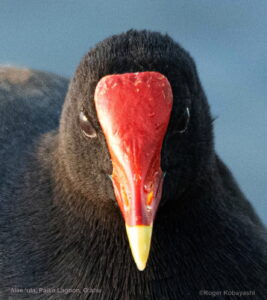
March 27, 2024
During a bike ride from my house to the Kailua YMCA, I came to a screeching halt on Hamakua Street, where an adult ʻalae ʻula, or Hawaiian Gallinule, lay motionless in the street, apparently hit by a car. The tragedy of this violent end to an endangered waterbird’s life brought tears to my eyes. I dropped my bicycle, wrapped the bird in the bottom of my T-shirt and walked to the edge of Hamakua Marsh. The least I can do, I thought, is return this native bird to its wetland home where nature can recycle it.
But nature had other plans. As I knelt along the streamside bushes, intending to push the carcass into the water to keep cats and mongooses from mutilating its lovely body, the ʻalae ʻula woke up. The stunned bird stood, shook its feathers, and gazed at me, as if thinking, “Where am I and who are you?” Then it stepped to the water and swam away.
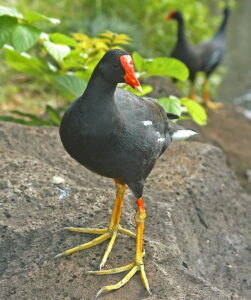
ʻAlae ʻula’s long, wide toes enable the birds to stand and walk on dense wetland vegetation. But even lacking webbed feet, the birds are good swimmers. Waimea Botanical Garden, Oʻahu. © Eric VanderWerf
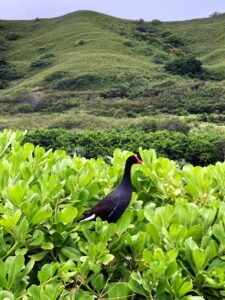
An ʻalae ʻula standing on naupaka bushes in Hamakua Marsh, Oʻahu. ©Susan Scott
The English names for this bird are confusing. Because close relatives of the ʻalae ʻula are found worldwide, different regions have different names. Also, as researchers learn more about species relationships through genetic analysis, scientific and common names change. Most common names, however, contain the word hen. Depending upon where in the world you see these birds, you’ll hear them called moorhens, marsh hens, mud hens, swamphens, and gallinules. (Gallinula, Latin for little hen, is the first scientific name of most moorhens.)
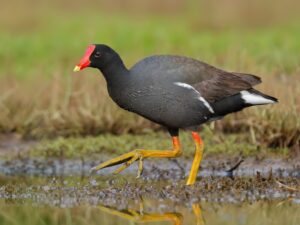
We think red for ʻalae ʻula (ʻula means red in Hawaiian) because of their red faces and red bands around the upper legs. Beak tips, legs, and toes, however, are bright yellow. Kawainui Marsh, Oʻahu © Sharif Uddin, Macaulay Library, eBird.
Moorhens are waterbirds that live in wetlands, marshes, canals, ponds, ditches, rice fields, and wet taro farms. ʻAlae ʻula are more secretive than their ‘alae kea (coot) relatives, hiding among submerged or floating vegetation as well as in shoreline shrubs and plants.
Although these birds are hard to find, and therefore, hard to count, the current Hawaiian Gallinule (the most recent common name declared by the American Ornithological Society) the Hawaiʻi population is estimated at 700 or so. Although once found throughout the main Hawaiian Islands, the birds today are found only on Kauai and Oahu mostly due to lost wetlands.
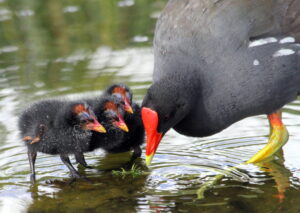
ʻAlae ʻula females lay an average of 5 eggs, with both parents taking turns sitting on them. Chicks hatch in about 3 weeks and are dependent for about a month on parents teaching them how to find food. Princeville pond. ©Hob Osterlund
Holding that wild bird in my hands gave me a special love of gallinules, especially since the bird gave me the happy surprise of being alive. As a result of that accidental rescue, I think of that ‘alae ‘ula as mine. And since I can’t tell one from another (males and females look alike), I now view every ʻalae ʻula I see at Hamakua Marsh as my own.
It’s a gift.
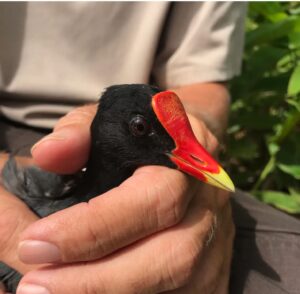
A bird in the hands of a federal researcher at Hanalei National Wildlife Refuge. © Helen Raine Pacific Birds Habitat Joint Venture, Kauai.